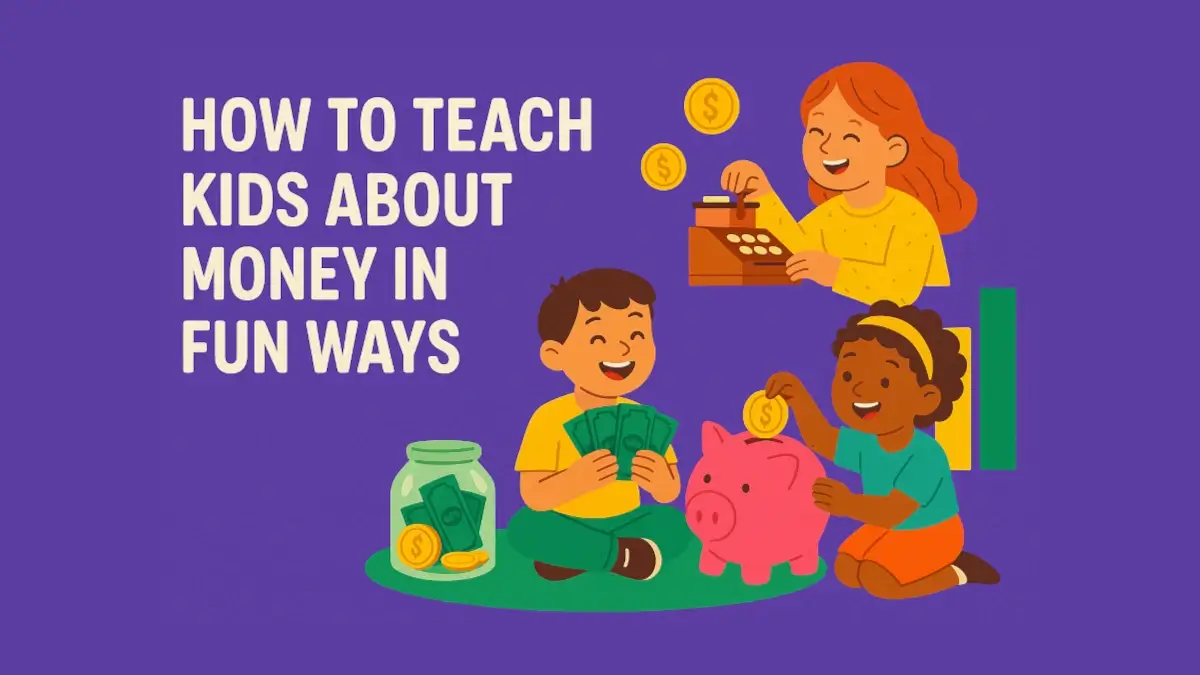Teaching kids about money is one of the most valuable lessons you can give them. Financial literacy is not taught deeply in schools, but it is a life skill that shapes how children handle money, save, invest, and make financial decisions in the future. The good news is—you don’t need to make it boring. With fun, interactive, and age-appropriate methods, kids can learn about money in ways they actually enjoy.

In this blog post, we’ll explore creative and fun ways to teach kids about money. Whether your child is a toddler, school-aged, or a teenager, these strategies will help you raise money-smart kids.
Why Teaching Kids About Money Matters?
- Builds Financial Responsibility: Kids learn the value of money and how hard it is to earn.
- Encourages Smart Spending: They understand the difference between wants vs. needs.
- Promotes Savings Habit Early: Small savings habits in childhood lead to big financial discipline in adulthood.
- Prepares for the Real World: Teens who understand budgeting and banking are less likely to fall into debt traps later.
Fun and Creative Ways to Teach Kids About Money.
1. Introduce Play Money and Role-Playing Games.
Children love role-play! Set up a pretend shop at home with toys, snacks, or stationery. Give them play money and let them “buy” and “sell.” This helps them understand the concept of exchange, cost, and value.
TIP: Rotate the shopkeeper role so they learn both buying and selling.
2. Use Piggy Banks and Clear Jars.
Instead of just giving pocket money, use three jars labeled Spend, Save, Give.
- Spend Jar: For small treats like candies or toys.
- Save Jar: For bigger goals like a new video game.
- Give Jar: To donate to charity or help others.
This simple trick visually teaches kids money management.
3. Play Board Games that Teach Money.
Games like Monopoly, The Game of Life, Pay Day, or even card-based games help kids understand money flow, risk, and reward in a playful manner.
BONUS: There are also online money games and apps designed for kids.
4. Turn Allowance into Lessons.
Instead of giving allowance with no strings attached, tie it to tasks, goals, or budgeting challenges. For example:
- Earn ₹100 for weekly chores.
- Save half for one month to get a bonus.
- Spend wisely and show receipts to discuss decisions.
This makes money real, not abstract.
5. Teach Through Everyday Activities.
When shopping for groceries, involve your kids:
- Give them a small budget and let them pick fruits.
- Compare brands and prices together.
- Show them discounts, offers, and why buying in bulk saves money.
Real-life money lessons stick better than lectures.
6. Introduce Digital Money Concepts.
As kids grow, they should understand digital money too:
- Use prepaid debit cards for teens.
- Explain online payments, UPI, and banking apps.
- Talk about the importance of online safety.
This prepares them for a cashless future.
7. Storytelling and Books About Money.
Read age-appropriate books on money management for kids. Stories make concepts memorable and relatable.
Some popular books:
- Money Ninja by Mary Nhin (for younger kids)
- The Everything Kids’ Money Book by Brette Sember (for older kids)
8. Savings Challenges and Goals.
Set fun savings goals like:
- “Let’s save for an ice cream party.”
- “We need ₹500 to buy a family board game.”
Track progress with a colorful chart or stickers. Kids love visuals and rewards.
9. Teach the Power of Interest.
Explain how savings grow with interest. A simple example:
- If they save ₹100 today and earn ₹5 interest each year, they’ll have more money without working for it.
- Use simple compounding games or apps to show growth visually.
10. Encourage Entrepreneurial Thinking.
Kids can learn by earning:
- Selling homemade crafts.
- Running a lemonade stand.
- Offering simple services like car washing.
This helps them connect hard work with earnings.
Age-Wise Money Lessons.
- Ages 3–6: Recognizing coins, play money, piggy bank savings.
- Ages 7–12: Allowance, budgeting jars, shopping comparisons.
- Ages 13–18: Digital money, bank accounts, saving for gadgets, part-time earning.
Common Mistakes Parents Make.
- Giving Money Without Teaching Value: Handing over money without context doesn’t help.
- Avoiding Money Talk: Kids should learn openly about finances, not in secrecy.
- Overcomplicating Concepts: Keep it simple and age-appropriate.
Final Thoughts.
Teaching kids about money doesn’t have to be boring or difficult. By using games, stories, and real-life examples, you can help your children become financially smart from a young age. Start small, be consistent, and watch your kids develop money habits that will benefit them for a lifetime.
FAQs About Teaching Kids Money.
Q1. At what age should I start teaching my child about money?
You can start as early as age 3 with simple activities like identifying coins and using piggy banks.
Q2. Should kids get pocket money or allowance?
Yes, but link it with responsibilities, chores, or financial lessons so they value it.
Q3. How do I teach teenagers about money?
Give them prepaid cards, involve them in family budgeting, and encourage part-time earning.
Q4. Can digital money confuse kids?
Not if explained properly. Use real-life examples like online payments for toys or food delivery.
Q5. What are the best money games for kids?
Monopoly, The Game of Life, Pay Day, and online apps like PiggyBot or Bankaroo.
Leave a Reply